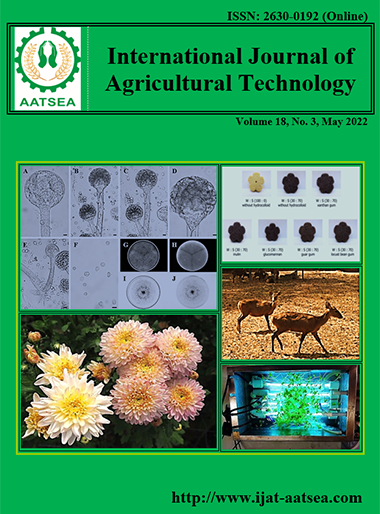Karyological analysis on wheat Tir (Triticum aestivum var. Aestivum L. spp. Leucospermum Körn.) ecotypes in Lake Van Basin, Turkey
Main Article Content
Abstract
Karyotypic is studied within ecotypes species which are importantly found with different ecotypes, and it may possible showing specific genomic adaptation with their environmental growing conditions. Chromosome karyotype and morphology in wheat Tir by analyzing chromosomes in five ecotypes (Ahlat, Ercis, Muradiye, Patnos and central part of Van) in order to present the best instruction for cytogenetic studies in chromosome analysis was investigatred. Pre-treatment with %1 alpha-bromo naphthalene, fixation in karnoy 1, hydrolysis in NaOH and staining by %2 Aceto-Orcein were proved using root meristem segments followed by studying the microscopic preparations. Karyotype analysis of each ecotype. There was separately performed and showing several indices (TL: Total Length, LA: Long Arm, SA: Short Arm, Sat: Satellite and AR: Arm Ratio). The somatic chromosome numbers of all studied ecotypes are hexaploid with 2n=6x=42 and the averages of chromosomes length ranged from 4.60 ± 0.02 µm to 16.05 ± 0.02 µm. The longest chromosome was observed in chromosome number 1 from ecotype 3 which belongs to Muradiye and the shortest one was related to the chromosome number 21 from ecotype 4 from Patnos
Article Details

This work is licensed under a Creative Commons Attribution-NonCommercial-NoDerivatives 4.0 International License.
References
Borem, A. and Fritch-neto, R. (2014). Biotechnologye and plant breeding. Academic Press is an imprint of Elsevier, pp.19-45.
Devos, K. and Gale, M. (1993). The genetic maps of wheat and their potential in plant breeding. Outlook on Agricultureis, 22:93-99.
Farshadfar, M., Safari, H., Shirvani, H. and Aghaeinia, S. (2020). Comparison of wheat-barely disomic addition lines using cytogenetical and molecular markers. Journal of Cellular and Molecular Research, 32:365-376.
Feridooni, L., Mehrabi, A. A. and Safari, H. (2017). Study of karyotypic relationships of D, S and U genomes of Aegilops with A genome of Triticum. Journal of Genetics, 3:397-409.
Gerlach, W. L. (1977). N banded karyotypes of wheat species. Chromosoma, 62:49-56.
Gill, B. S. (1987). Chromosome banding methods, standard band nomeclature, and applications in cytogenetic analysis IN Wheat and Wheat Improvement. Agronomy Monograph. 2nd Ed, 13:243-254.
Gill, B. S. and Kimber, G. (1977). Recognition of translocations and alien chromosome transfers in wheat by the Giemsa C-banding technique. Crop Science, 17:264-266.
Ghorbani-Sini, F. and Arzani, A. (2015). Karyological studies in Triticum monococcum subsp. aegilopoides and Aegilops cylindrica species grown wild pairwise in west Iran. Rostaniha, 16:164-173.
Hilu, K. W. (2004) Phylogenetics and chromosomal evolution in the Poaceae (Grasses). Australian Journal of Botany, 52:13-22.
Jaffar_Aghaei, M., Naghavi, M. R., Talaeei, A. R., Omidi, M. and Mozafari, J. (2007). A study of chromosome homology between three Iranian Aegilops species with D genome and bread wheat (T. aestivum). Iranian Journal of Rangelands Forests Plant Breeding and Genetic Research, 2:95-112.
Karimiafshar, N., Dashti, H., Mohamadi mirik, A. A. and Arab-bagi, M. (2016). Cytogenetical and morphological diversity of wild types of wheat. Modern Genetics Journal, 11:437-448.
Kharazian, N. (2008). Chemotaxonomics studies on Aegilops L. (Poaceae) in Iran. Pakistan Journal of Biological Sciences, 11:1204-1211.
Levan, A., Fedga, K. and Sandberg, A. A. (1964) Nomenclature for centromeric position on chromosomes. Hereditas, 52:201.
Ranjbar, M. and Naghavi, M. R. (2007). Multivariate Analysis of Morphological Variation in Aegilops crassa from Iran. Pakistan Journal of Biological Sciences, 10:1126-1129.
Safari, Z. and Mehrabi, A. (2021). Evaluation of evolutionary relationships incultivated wheat and its wild relatives (Aegilops L. and Triticum L.) using karyotype analysis. Modern Genetics, 15:337-349.
Sliai, A. M. and Amer, S. A. M. (2011). Contribution of chloroplast DNA in the biodiversity of some Aegilops species. African Journal of Biotechnology, 10:2212-2215.
Stebbins, G. L. (1971). Chromosomal evolution in higher plants. Edward Arnold Publisher, London. 216 p.


